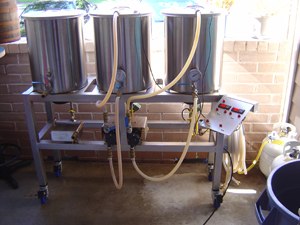
Gas-fired SS Mash Tun - How does it work?
#1

Posted 08 April 2009 - 01:46 PM
#2

Posted 08 April 2009 - 01:52 PM
#3

Posted 08 April 2009 - 02:14 PM
#4

Posted 08 April 2009 - 02:16 PM
#5

Posted 08 April 2009 - 02:24 PM

 I don't have the resources to invest in a pump, but I imagine if I go with a wetter mash and stir constantly I'll avoid scorching. In fact, I'll be brewing this weekend, maybe I'll test it out...
I don't have the resources to invest in a pump, but I imagine if I go with a wetter mash and stir constantly I'll avoid scorching. In fact, I'll be brewing this weekend, maybe I'll test it out...
#6

Posted 08 April 2009 - 02:31 PM
#7

Posted 08 April 2009 - 02:46 PM

#8

Posted 08 April 2009 - 03:49 PM
#9

Posted 09 April 2009 - 07:23 PM
#10

Posted 09 April 2009 - 07:51 PM
#11

Posted 09 April 2009 - 09:06 PM
Not hating Bill. But I have three vessels, one is a 10gl round plastic cooler and two are sanke kegs. The cooler used to be my mash tun, now it's an HLT. My sanke HLT is now my mashtun. The copper manifold I used in the cooler fit nicely in the sanke with little modification (longer dip-tube). By switching the two vessels, mashtun volume increased by over 50% which means I can brew stronger beers. I prefer to direct-fire my MT so I don't have to calculate temp loss during transfer from HLT to MT. I also do a RIMS with direct fire so SS is necessary. With a HERMS, it wouldn't be.What is the advantage of using SS for a mashtun in a home brew situation? I see all the rigs with SS tuns and I've never figured out why. I still use 3 vessels, it's just that one is 60 qt plastic Igloo cooler and cannot be direct fired, nor does it need to be.
There is always temp loss, but mostly negligible over the amount of time the average brewer mashes which is typically 60 min. There are many options available for insulating keggles but I won't go into that here. A few towels or blankets can help out on a cold day. The thermal mass will carry over the duration of the mash without the need for serious insulation.I've always wondered how someone mashes in a SS keggle and doesn't loose temp. I always have a ~7° temp drop in my cooler and that is simply due to equalization of the thermal mass of the cooler, but after that, it might drop 1° in an hour.
#12

Posted 10 April 2009 - 06:39 AM
They both work, and both have their advantages. The coolers are normally less expensive (althought the 10 gallon round igloos can be expensive) hold heat better, and lighter. The downside is people have had them warp when they add there strike water, can stain, hold flavors, and need to account for the termal mass either with a calculation or preheating the tun. You also have a temp loss potention from HLT to MLT. The SS takes the thermal loss out of the equation. Since you would have heated up the stike water in the vessel you will nail the temp everytime w/o any loss in temp. You can also save time, I normally get everything ready the night before, so my strike water is in my tun and sparge water is in the hlt. All I need to do is turn the HLT on in the morning. Since they are SS they should last forever, will not hold flavors or warp.An unisulated SS tun has the potential to loos a greater amount of temp durning the mash than a cooler. I normally place a wool blanket over it and will lose 1-2 degrees over an hour. I have mashed w/o the blanket and lost 5-7 degrees during the mash. The biggest disadvantage is if you lose a converted keg and it is elevated, which discribes mine. My basic layout is similare to a b3 1550. The mlt is the top level with the hlt directly below it, the top of my mlt is 6'2". So I need to lift that down 30lb keg, 30lbs of grain, and around 5 gallons of absorbed water at 8lbs per gallon adds another 40lb. That is 100lbs that I need to lift down. Another disadvantage is that that the outside can be hot and better chance to burn you than a cooler (but you are more likely to burn yourself on your kettle.What is the advantage of using SS for a mashtun in a home brew situation? I see all the rigs with SS tuns and I've never figured out why. I still use 3 vessels, it's just that one is 60 qt plastic Igloo cooler and cannot be direct fired, nor does it need to be.I use my IC has my HERMS simply by heating my HLT and having my IC in there. That can easily be used for step mashing without the worry of direct-firing your MT.I've always wondered how someone mashes in a SS keggle and doesn't loose temp. I always have a ~7° temp drop in my cooler and that is simply due to equalization of the thermal mass of the cooler, but after that, it might drop 1° in an hour.
#13

Posted 10 April 2009 - 12:43 PM
 After using fancy and expensive metal backed foam for insulating my keg mash tun, I found that the two Mexican blankets off the sofa work best.
After using fancy and expensive metal backed foam for insulating my keg mash tun, I found that the two Mexican blankets off the sofa work best.
#14

Posted 10 April 2009 - 12:46 PM
#15

Posted 10 April 2009 - 12:52 PM
Thanks, I wouldn't want to be without all the great folks that have guided me toward good beer for so long!Good to see you over here Dean.
#16

Posted 14 April 2009 - 07:54 AM
#17

Posted 14 April 2009 - 04:58 PM
I use the same for the mash and hold the temp in a sanke for an hour with no more than a 2-4 degree loss. I then turn on the flame again and slowly recirc and at the same time bring my mash up to 168 before I start the sparge. Never burned it but I do take the heat up at a slow pace
After using fancy and expensive metal backed foam for insulating my keg mash tun, I found that the two Mexican blankets off the sofa work best.
#18

Posted 16 April 2009 - 05:02 AM
#19

Posted 16 April 2009 - 07:15 AM
Quite a few years ago there was a home brewer who was working on a propane powered beer cooler. He came up with putting a propane tank in a bushel basket sized container with water and the beer. Then he fired up a jet engine like thing with the propane. As the pressure in the tank dropped, it chilled and passed the coolness on to the water in the basket which then passed it onto the beer. Used to be a web page, but I long since lost the link. Google probably knows where it is, but I am too lazy today to hunt for it.When you guys noodle out how to fire a SS Mash tun, you're ready for the next riddle:Gas fired air conditioning.Hint: Ammonium Cycle.
#20

Posted 16 April 2009 - 08:18 AM
0 user(s) are reading this topic
0 members, 0 guests, 0 anonymous users


















